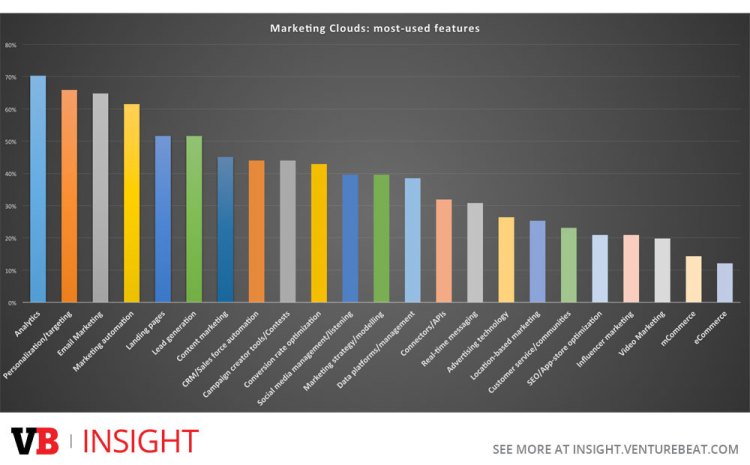In a 2,000-product marketing technology ecosystem, marketing clouds attempt to bring all the functionality you need into one place, in one system of record, with one unified profile of your customers, and one unified, simple user interface to control it all.
At least, that’s the theory.
To find and report the reality, we recently released what is probably the most detailed, thorough, and data-driven marketing clouds report ever created. And in doing so, we discovered the five different kinds of marketing clouds.

Above: Marketing clouds by penetration online
1: Aggregated marketing clouds
Aggregated marketing clouds are built via acquisition. They typically have both broad and deep features, but those features can be siloed into different islands of functionality if the company has not spent considerable time and effort integrating them.
The aggregated marketing clouds include:
- Adobe
- HP
- IBM
- Oracle
- Salesforce
- SAP
- SAS
These are typically designed for the enterprise first, then the midmarket. Social features and functionality are typically strong here.
External integration is still something that matters to those who choose marketing cloud vendors. As fully featured as some of them are, there are always little bits of extra functionality you will want to incorporate, so when judging aggregated marketing clouds, look for an app marketplace, which will vastly expand and simplify your integration options.
Get the whole story in our report:
Marketing clouds: How the best companies are winning via marketing technology
2: Grown-up marketing automation platforms
These marketing clouds began life as “simple” marketing automation systems, but have since grown tremendously beyond that.
The grown-up marketing automation platforms (MAP) are:
- HubSpot
- Marketo
Typically, these do not offer as many features or the feature depth of the best aggregated marketing clouds, although they certainly surpass some of those players. However, they do share one very important characteristic: They were built as a single platform that is fully integrated, speaks to one database, and has a consistent user interface throughout.
These can cover different levels, with Marketo more on the enterprise and HubSpot more on the midsize markets.
Generally, these were born on the web and are strongest there. Mobile is not their strongest suit, nor is social.

Above: The most-used features in marketing clouds
3: Single platform multi-use purpose-built platforms
These are typically platforms built for a single defined purpose — personalization, customer experience, or omnichannel — which have added features and functionality to achieve that goal in all areas.
These marketing clouds include:
- SDL
- Sitecore
- Sailthru
- AgilOne
- IgnitionOne (although this company has started to do some acquisitions lately)
Generally, they are not as feature-rich as the big aggregated platforms, but like the grown-up marketing automation systems, they are typically better internally integrated in terms of data, applications, and user interface, since they were built as a single platform by a single company.
 Since these originate out of the customer experience and omnichannel spaces, they typically have very strong commerce and website integration, but may have limited social features and in certain cases limited mobile features.
Since these originate out of the customer experience and omnichannel spaces, they typically have very strong commerce and website integration, but may have limited social features and in certain cases limited mobile features.
These systems typically have very deep features in their core area of focus — deeper than you can get from an aggregated cloud or a grown-up MAP — but also tend to have somewhat shallower features in more recently added breadth areas. These systems typically have extreme enterprise capability and scalability in their core areas of strength.
Some do, however, have feature gaps that certain companies can live with and others cannot.
And, an important note about SDL and Sitecore:
These solutions arose out of the customer experience space, and they are heavily tied into web content management systems. That means that they are not quite as cloudy as some of the other clouds; they require a certain technology base for your web properties. So where for an Adobe or a Salesforce or HubSpot you don’t really care what technologies the marketing cloud uses, for these you do. This is not necessarily a problem, but it can be if their core underlying technologies are not compatible with your chosen stack and/or vision.
4: Proto-clouds
Proto-clouds are solutions that are adding significant marketing technology capabilities and will likely be marketing clouds at some point, but may not be quite there yet.
These include:
- Neustar
- Redpoint
- Tealium
- Ensighten
Proto-clouds typically have serious capability in key areas of marketing technology, and a strong desire to expand into a complete marketing cloud, but currently have limited breadth and depth of features. In addition, these companies have a significant and remaining focus on other business segments — the core businesses from which they may be expanding.
These can be good options if you’re already using their other services, but are less likely to be appealing if you are not.
Other companies that could fit here include DataXu and Infor.
Simple/cheap omnichannel
There are a number of small, young, scrappy companies rising up that offer omnichannel solutions. We just focused on one for this particular report, V12, but could have included others, including marketing automation systems that are adding omnichannel features.
These solutions tend to be simple, cheap, and quick. They can be very worthwhile for small companies and startups, where they are targeted, but larger firms will quickly outgrow their features.
The feature range is often broad, while depth is thin.
The entire report is available on VB Insight.
VentureBeat's mission is to be a digital town square for technical decision-makers to gain knowledge about transformative enterprise technology and transact. Learn More

